We independently evaluate all recommended products and services. Any products or services put forward appear in no particular order. If you click on links we provide, we may receive compensation.
What is a Guru? In Buddhist and Hindu religions, a Guru is a spiritual teacher or leader. It’s also used in less specifically religious context to refer to an influential teacher in a certain sphere – like a “Guru of building model cars” or that type of thing. It’s also a maker-collaboration knife between Matt Degnan and Kizer as part of the Bladesmith series. The Guru is a production version of Degnan’s MC model, named after his personal knife guru Matt Cucchiara.

Key Specs: Kizer Guru
So we have two knives that are almost identical in terms of specifications – weight, materials, etc – but with two separate deployment methods. This gives us a way to shed a little more light on the classic discussion of flippers versus thumb studs while removing all of the other independent variables that normally cloud up a discussion like this. Of course, we’ll also be examining the Guru itself in detail, to see if it’s a knife that deserves space in your pocket – and perhaps which version to prioritize.
The Blade
The blades on both Gurus are basically identical in terms of dimensions. They use a very stout Sheepsfoot blade shape measuring 3” long with a 2.75” cutting edge, cut from chunky 0.14” blade stock. A medium height flat grind combined with a sizable flat portion makes for a very strong blade, with tons of material behind the tip.
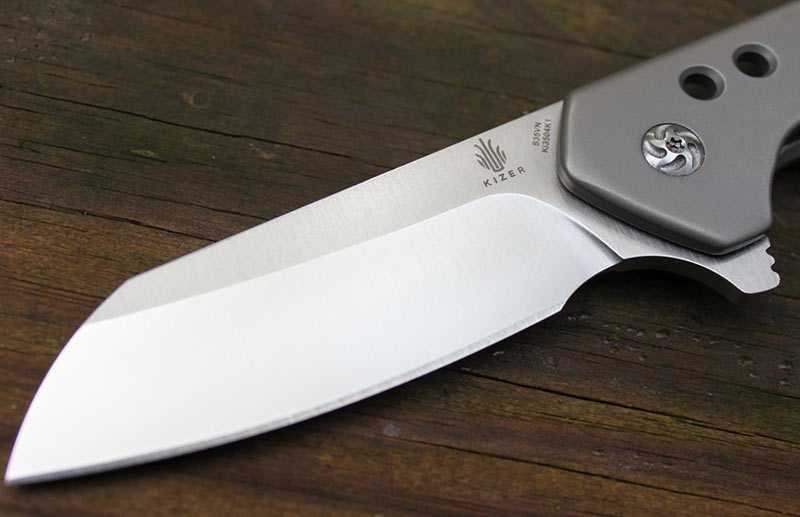
The plunge grind on these knives is diagonal, and intersects a wide forward finger choil well behind the end of the edge, leaving the entire sharpened edge uniform without any “beard.” Other than one having a flipper tab and the other having a thumb stud, the only discernible difference between the two is that the flipper variant has a slightly longer forward finger choil.
Blade steel is Crucible CPM-S35VN, well known in the knife community as the standard bearer of good mid-range steels. Those who are regular readers of Knife Informer will know this by now, but for those unfamiliar: S35VN was intended as an update of S30V, a powdered metallurgy steel that was actually designed with cutlery in mind. This isn’t normally the case with a lot of the steels that wind up in knives, but indeed Chris Reeve had a hand in the development of both S30V and S35VN in collaboration with Crucible, along with some big names like Paul Bos and Sal Glesser.

The big difference between S30V and S35VN is the addition of Niobium and the reduction of carbon and vanadium content – this gives S35VN similar edge retention characteristics to S30V but with greater toughness, being less prone to edge chipping when hardened and making it slightly easier to machine and sharpen. While S30V was once considered the peak of cutlery steels, today S35VN is considered a nice mid-range balance: it’s got significantly less carbon (1.4 to 1.9) and chromium (14 to 20) than a modern super steel like M390.
Deployment & Lockup
Ahh, here’s the difference. It’s unusual for one knife to be available with two different opening mechanisms, but the Kizer Guru manages to incorporate both styles very successfully.
First, the thumb stud. These days, thumb studs seem to be going out of vogue in favor of flippers, but they’re not without their benefits! They don’t snag on your pocket on the way out or tap the corners of your cell phone. The overall profile of the knife in pocket is narrower as well. The thumb stud Guru is a rare beast these days – a framelock knife with a bearing pivot that’s not a flipper, and it’s awesome. The detent is well judged here for thumb stud use, being able to reliably flip out without misfiring or needing a wrist flick either. After disassembly, cleaning and oiling the action was drop-shut smooth with the pivot dialed in for no blade play. Kizer obviously knows how to do bearing pivots.
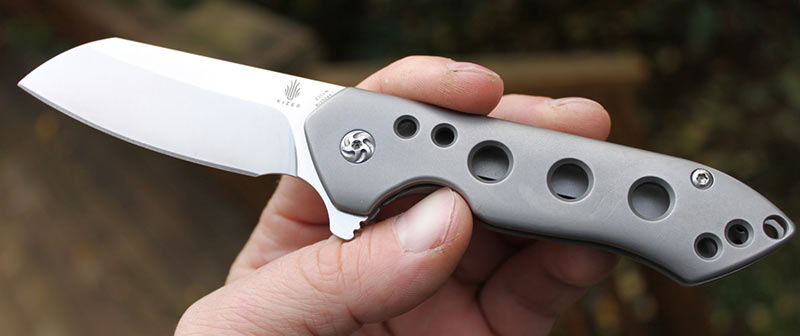
The flipper in my eyes isn’t as special. It feels like it has the same detent strength as the thumb stud, which I think is a little light for a flipper, and it feels a bit sluggish with the light detent and the weight of the blade. Perhaps it’s a matter of expectations – other than the ZT 0850 (which is going out of production) I can’t think of many other bearing pivot thumb stud knives, but the world is overrun with bearing pivot flippers. It also drops shuts after disassembly cleaning and lubrication, and it’s no surprise – it uses the same pivot components. The flipper tab is chunky with a squared off tip and some wide jimping for traction, requiring a lightswitch-style pull. They skipped any irritating jimping in the “landing zone” on the spine of the handle as well.
It’s not that the action on the flipper model is even bad; it’s just the preponderance of bearing flippers and the uniqueness of bearing thumb stud knives makes the action on the thumb stud model more compelling to me personally. It does flip well.
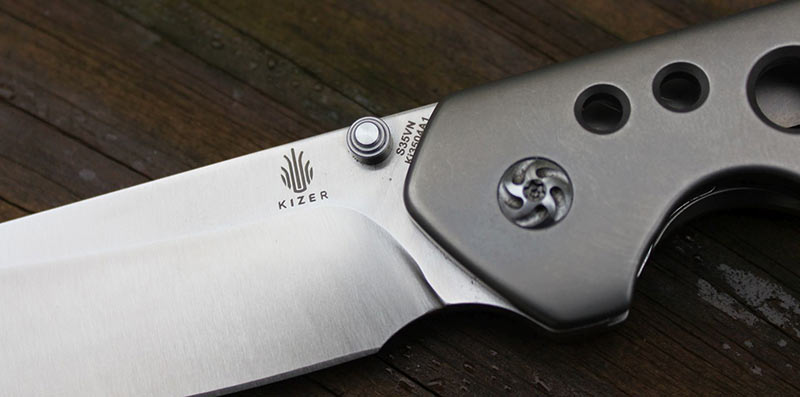
Lockup on both examples is flawless. They use stainless lockbar inserts bolted to the titanium frame that also serve as overtravel stops – a Hinderer innovation that prevents lockbar fatigue. The flipper model had later lockup than the thumb stud, visually about 40% versus maybe 25% for the stud model, but neither knife exhibits any horizontal or vertical blade play when open, nor do they have any notable lock rock or engagement issues. There isn’t any hint of lock stick either – these knives have the locks perfectly dialed in. Lockbar tension on the thumb stud feels slightly lighter than the flipper.
Features, Fit & Finish
Both knives feature titanium framelocks with flow through construction – nothing super unusual here. These models were both the milled handle versions which have a series of chamfered holes drilled in the show side. There’s not any stated weight difference between the milled and plain handles (at least according to listings on BladeHQ as well as Kizer’s website) so it’s a stylistic choice, and for me the hole patterns are just more interesting to look at. They feature matte finish titanium handles and satin blades for a clean, classic look.
Like all the new Kizer Bladesmith series knives (including the previously reviewed Feist) the Gurus have sculpted titanium pocket clips, and I’m starting to come around on this topic as these are pretty good. They’re quite robust and are anchored by two side by side screws, configured for tip up right hand carry only.

I had a few notes during disassembly. Kizer as a company is known for their CQI – fixing issues and updating designs while they’re still making a knife, and I’ve got some suggestions. Eliminating the free-spinning pivot will go a long way towards making disassembly/assembly and maintenance easier, and will probably eliminate a lot of warranty claims and shipping issues.
The female side of the pivot – a Chicago style screw with decorative torx heads on both sides – isn’t keyed to the frame on the lock side, so you need to have two separate bit drivers and T8 bits to take the knife apart, and with the threadlocker they put on the pivot screw you’ll have to do the hokie pokie to get the screw loose. A D-shaped (or “keyed”) pivot barrel that slides into a matching hole on the lock side would keep the pivot from turning and eliminate this issue. It’s not a deal-breaker but it’s odd that these knives at $180 retail don’t have this while the $45 Tangram Vector does – maybe it will become a feature on a future update.
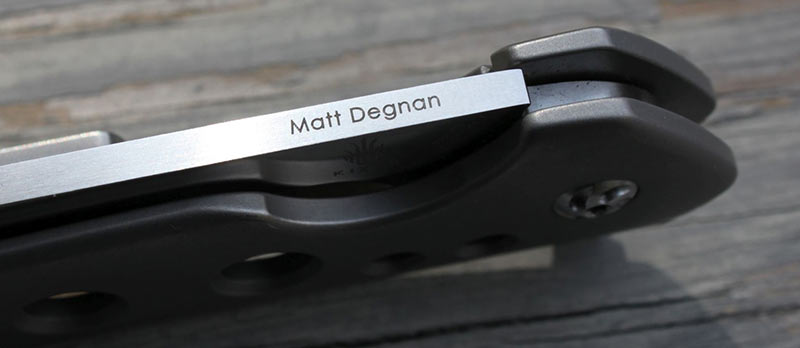
Also noted during disassembly are the washers that fit tightly in the reliefs cut into the frame for the bearing cartridges to fit in. This is a good idea – the bearings (which are contained in a plastic cartridge) that the blade rotates on are much harder than the titanium handles, so placing these washers in between the bearings and the inner handle prevents wear on the titanium itself which would lead to play. I noticed a visible groove in these washers on disassembly; I’m not sure if this is from break-in or if the washers are machined that way, but they’re plenty thick to prevent wear.
Construction is surprisingly sparse on these knives – just a pivot screw and a single body screw hold these knives together. To that end, the body screw threads into a polished steel standoff, and the standoff has a tubular section that fits into the handles rather than just sitting flat to stabilize the frame. Both variants utilize an external stop pin anchored in the handles, which is theoretically stronger than an internal stop pin and also prevents the build-up of gun in an internal stop pin track. Also, the last “hole” in the pattern on the frame is also there on the plain handled version – it’s the lanyard hole and it passes through both sides.
Although the Guru is a pretty staid design, there are still some small details to delight those who look closer. One thing Kizer does on most of their Bladesmith lines is present here – very light texturing on the scalloped lockbar cutout where your thumb goes, theoretically for better grip but probably for aesthetics as well. The machining on the handles is impressive – there’s a gentle contour to their profile, and all of the holes drilled in the show side are chamfered – the handles are soft to the touch, no sharp edges even on the inner corners along the spine, but it still fills your hand reassuringly.
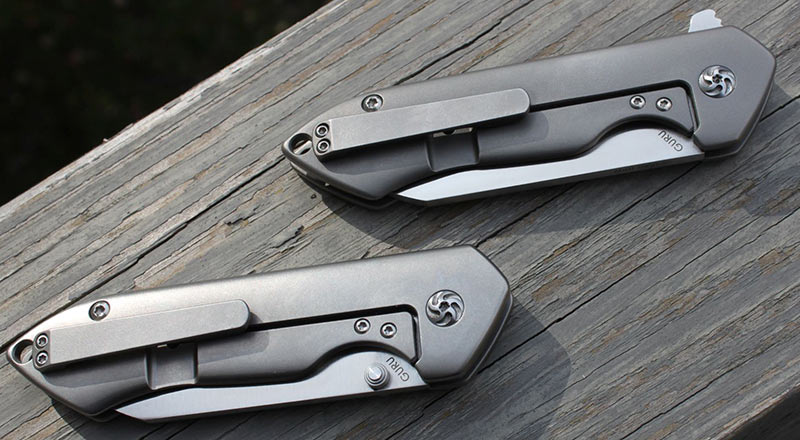
One odd difference – the flipper variant of this knife has “Matt Degnan” etched on the spine, but the thumb stud version doesn’t. As far as fit and finish, these knives are (like most of Kizer’s Bladesmith series) among the best in the business. Perfect blade centering, even symmetrical grinds, no rough edges left behind during machining, even the insides of this knife when disassembled are nice. I do think that Kizer can put better final edges on these knives before they ship them out, as neither of them were impressively sharp from the factory, but they were even.
Field Test
Despite the titanium construction these knives are still fairly heavy at just over 4 ounces for a 3” blade. They’re also fairly wide in pocket with the handles measuring 0.45” across, so you won’t forget you’re carrying it like a lot of other knives in the 3” range. The pocket clip is pretty good, though – although I always prefer a plain spring clip to a fancy milled titanium clip, this one avoids a lot of the problems that earlier milled clips had. It has sufficient spring tension thanks to a relatively thick “bridge” section, but the forward edge of the contact point is angled such that you can easily slip it over the hem of your pocket.
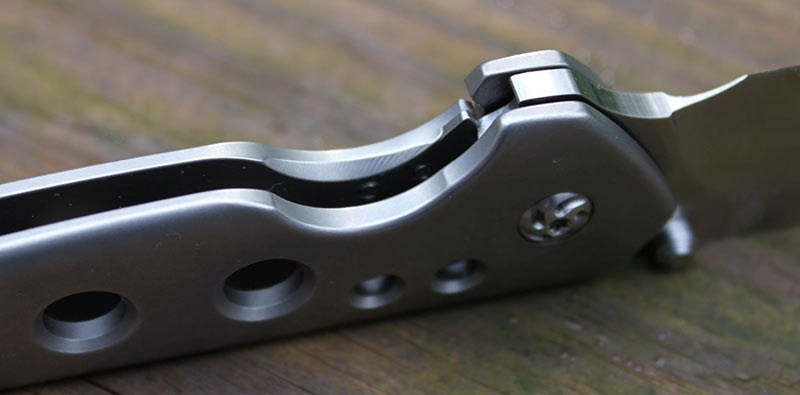
For carry the only difference is the extra space between the flipper and the regular version; obviously the plain version pulls out of the pocket a little easier. Neither pendulum on the pocket, although I have noticed that the blunt tip of the clip can sometimes get hung up on the hem of a heavy shirt or light jacket and pull the knife upwards which is disconcerting.
I think my issue with this knife in use is the thickness of the blade. Although .14” doesn’t sound like a subway sandwich on paper, the combination of the short primary bevel and tall flat section mean that this knife is thick behind the edge. Combined with the tip-downward balance of the Sheepsfoot blade, and you have a theoretical hard-use pattern on a 3” blade with a 2.75” cutting edge. What sort of hard-use tasks are you going to do with a 2.75” cutting edge? I’m not sure. I found the Guru’s lack of slicing ability and tendency to hang up in cardboard an odd frustration for a knife of this size. I think narrowing the blade stock – or better yet, hollow grinding the primary bevel – would go far in the cutting performance of these knives. And as good looking as Sheepsfoot blades are, I still prefer a drop point for EDC use for the piercing ability of the tip.
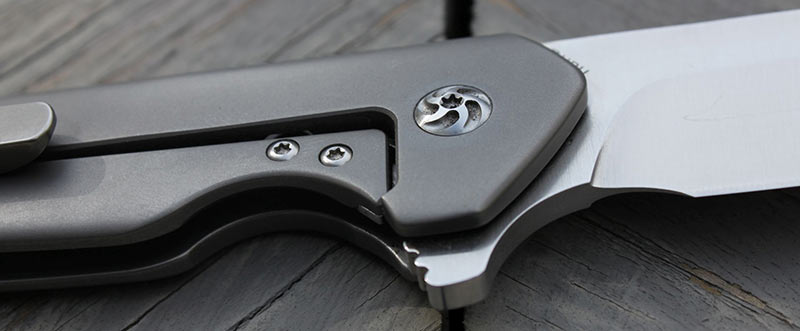
As far as ergonomics in use, this is a very solid design. The depth of the contoured handles with their no-rough-edges finish, the well-defined finger choils ahead of and behind the pivot giving you a choice in grips, the unobtrusive pocket clip, you wind up with a weird balance: a knife that doesn’t cut spectacularly, but is very well made and comfortable in hand. The lock is easy to manipulate thanks to well-judged tension and a good thumb cutout and never showed any signs of play. The bearing pivot is an absolute joy to actuate. It’s a fantastic knife to carry, I just wish it cut better.
As far as maintenance goes, the Gurus are great with the exception of the spinning pivot. I didn’t end up having a problem getting the pivot loose but these still have the old-style decorative pivots which from anecdotal evidence are prone to stripping. Kizer has gone with a new design pivot that looks more solid, so we’ll see. Maintenance is a snap and knives go together just as easily as they come apart. Sharpening is also nice, where the broad flats make it easy to attach a guided rod system clamp securely and the well-terminated sharpened edge means there’s no beard to deal with.
Alternatives
All these knives available at BladeHQ.
At BladeHQ, the flipper model retails for about $180 and the thumb stud retails for a few bucks less. I’m not sure why there’s the price discrepancy, but I’ll take a medium coffee and the thumb stud variant for my money. If you don’t want the holes in the handle, the plain handled variants are the same price.Since I was talking about the relative scarcity of thumb stud bearing pivot knives, another one to bring up is the stunning – and recently discontinued, sadly – ZT 0850, which is a Todd Rexford/Dmitry Sinkevich collaboration. It also has a (modified) Sheepsfoot blade, made from CPM 20CV steel. There’s all kinds of neat details: the blue weave in the carbon fiber scales, the detailed thumb stud, the clever sub-frame lock with steel insert, a milled titanium clip, an intricate machined backspacer, the list goes on. It’s a lot bigger than the Guru at 3.75” and it’s also way more expensive, ~$230 on closeout before they’re gone.

More of a direct competitor from ZT is the Sinkevich 0456 (BladeHQ | Amazon) . It’s a titanium-handled bearing flipper with a stout sheepsfoot blade, 3.25” of CPM 20CV steel. It’s much heavier at 6.5 ounces, although there’s a new carbon fiber sprint run recently released that’s under 5 ounces total. It’s certainly more ornate than the Guru, with anodized blue pivot hardware, backspacer and pocket clip, and it’s also about $60 harder on your wallet.

If you’re looking for another Sheepsfoot blade in this price range, the Guru is slightly more expensive than the Benchmade 555-1 Mini Griptilian (BladeHQ | Amazon) , in the recent grey G10/CPM 20CV steel configuration. These are excellent everyday carry knives at $165 retail for the 2.91” mini size, or just under $180 for the 3.4” full size. Obviously construction and materials are different and the Griptilian uses Benchmade’s well known Axis lock.

Another very similar design is the Boker Plus Impetus, a collaboration with Burchtree knives. The Impetus also has a broad sheepsfoot blade with a short primary bevel, measuring in at 3.25” and 7.25” overall. Blade steel is 440C stainless, a step down from S35VN, but the price is also lower at ~$120 retail. What’s not lower is the weight, which is a frankly impressive 7.45 ounces – sure to pull your pants down if you forget a belt. It also flips on ball bearings.

What might be the most direct competitor for the Guru comes from Kizer themselves, though: the highly popular Sheepdog line of knives. The full sized Sheepdog has a 3.25” S35VN blade which is a combination of Sheepsfoot and cleaver. It’s chunkier at 6.17 ounces, but the distinctive style of the knife is the real polarizing aspect: either you see it and immediately want one, or you don’t. I personally like the Guru better. The blade is even thicker on the Sheepdog, at 0.16” wide.
Wrap-up
I’ve handled and reviewed a good number of products from both Kizer and their budget sub-brand Tangram at this point, and I’m consistently impressed. None of them are perfect (although the Feist comes close!) but they’re all remarkably well made knives that represent great value for money as well as very clearly conveying the design ethos of who imagined them. The Guru is a faithful production interpretation of the MC custom that pays tribute to Matt Cucchiara, and like many of the other Bladesmith series knives it makes such a unique custom design not only available to the average consumer but also usable.

The combination of unique design and impressive build is enough to sway me over the relative lack of cutting performance most of the time, but I think I’d be more prone to carrying the Guru more often if it was thinner or hollow ground – or both. I’d also like to see a captured pivot and Kizer’s newer pivot hardware, but other than that I’ve not got any complaints.
Of course the real question here is – thumb stud or flipper? For me it has to be the thumb stud. I’m inundated with titanium flippers and the Guru’s action isn’t exceptional. There’s a real lack of high end thumb stud knives though, and the silky-smooth pivot of the standard model makes it a real joy to use – and it’s also a better fit in your pockets and it’s nicer looking (to my eyes, at least.)
You can read more reviews on Kizer knives like the Original Serape, Cormorant Serape, Begleiter, Matanzas, Feist, Rattler, and Kyre.
- Exceptionally well built, great looking, rare to see a bearing pivot thumb stud knife these days
- Needs to have thinner blade stock or a hollow grind (or both) to cut well, free spinning pivot, action on flipper version is just “OK”
Kizer Guru
Quality/Performance - 73%
Value for Money - 67%
70%
A charismatic maker collaboration that lets you choose how you like it, better with a thumb stud.
Reviewer: James Mackintosh
Kizer Cutlery provided these knives for the purposes of a review.





